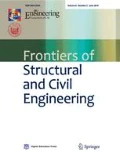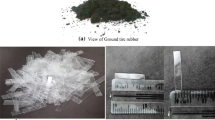Abstract
Polyethylene terephthalate bottles production has drastically increased year after year due to high versatility of polyethylene terephthalate plastics and considerable consumption of beverages. In tandem with that increase, the major concern of society has been the improper disposal of this non-biodegradable material to the environment. To deal with this concern, recycled polyethylene terephthalate bottles were incorporated in concrete as fibre reinforcements in this study. The objective of this research is to evaluate the mechanical properties of recycled polyethylene terephthalate fibre reinforced concrete (RPFRC) in comparison with control concrete without fibres. polyethylene terephthalate fibres with three different diameters (0.45, 0.65, and 1.0 mm) and two lengths (20 and 30 mm) were added at various proportions (0.5%, 1.0%, 1.5% and 2.0%) by volume of concrete in order to determine the effect of fibres initially on compressive, flexural and splitting tensile strengths of concrete. The results revealed that none of the fibres have detrimental effects up to 1 % volume fraction, however further addition caused slight reductions on mechanical properties in some conditions. Plastic shrinkage resistance and impact resistance tests were also performed according to related standards. Polyethylene terephthalate fibres were observed to have marked improvements on those properties. Such a good performance could be attributed primarily to the bridging effect of fibres.
Similar content being viewed by others
References
Association of Plastic Manufacturers. An analysis of European plastics production, demand and waste data. 2018 (available at the website of Plasticseurope)
Plastics Europe (PEMRG). Production of plastics worldwide from 1950 to 2019 (in million metric tons). 2020 (available at the website of Statista)
Business Wire. Polyethylene terephthalate (PET) production worldwide in 2014 and 2020 (in million metric tons). 2015 (available at the website of Statista)
Pereira de Oliveira L A, Castro-Gomes J P. Physical and mechanical behaviour of recycled PET fibre reinforced mortar. Construction & Building Materials, 2011, 25(4): 1712–1717
Azhdarpour A M, Nikoudel M R, Taheri M. The effect of using polyethylene terephthalate particles on physical and strength-related properties of concrete: A laboratory evaluation. Construction & Building Materials, 2016, 109: 55–62
Bui N K, Satomi T, Takahashi H. Recycling woven plastic sack waste and PET bottle waste as fiber in recycled aggregate concrete: An experimental study. Waste Management (New York, N.Y.), 2018, 78: 79–93
Won J P, Jang C I, Lee S W, Lee S J, Kim H Y. Long-term performance of recycled PET fibre-reinforced cement composites. Construction & Building Materials, 2010, 24(5): 660–665
Fraternali F, Ciancia V, Chechile R, Rizzano G, Feo L, Incarnato L. Experimental study of the thermo-mechanical properties of recycled PET fiber-reinforced concrete. Composite Structures, 2011, 93(9): 2368–2374
Pelisser F, Montedo O R K, Gleize P J P, Roman H R. Mechanical properties of recycled PET fibers in concrete. Materials Research, 2012, 15(4): 679–686
Borg R P, Baldacchino O, Ferrara L. Early age performance and mechanical characteristics of recycled PET fibre reinforced concrete. Construction & Building Materials, 2016, 108: 29–47
Kim S B, Yi N H, Kim H Y, Kim J H J, Song Y C. Material and structural performance evaluation of recycled PET fiber reinforced concrete. Cement and Concrete Composites, 2010, 32(3): 232–240
Wang J Y, Chia K S, Liew J Y R, Zhang M H. Flexural performance of fiber-reinforced ultra lightweight cement composites with low fiber content. Cement and Concrete Composites, 2013, 43: 39–47
Ochi T, Okubo S, Fukui K. Development of recycled PET fiber and its application as concrete-reinforcing fiber. Cement and Concrete Composites, 2007, 29(6): 448–455
Sivakumar A, Santhanam M. A quantitative study on the plastic shrinkage cracking in high strength hybrid fibre reinforced concrete. Cement and Concrete Composites, 2007, 29(7): 575–581
Kim J H J, Park C G, Lee S W, Lee S W, Won J P. Effects of the geometry of recycled PET fiber reinforcement on shrinkage cracking of cement-based composites. Composites Part B, Engineering, 2008, 39(3): 442–450
ASTM Standard C192/192M-16a. Making and Curing Concrete Test Specimens in the Laboratory. West Conshohocken, PA: ASTM, 2016
ASTM Standards C1579–13. Standard Test Method for Evaluating Plastic Shrinkage Cracking of Restrained Fiber Reinforced Concrete (Using a Steel Form Insert). West Conshohocken, PA: ASTM, 2013
ASTM Standard C403/403M. Standard Test Method for Time of Setting of Concrete Mixtures by Penetration Resistance. West Conshohocken, PA: ASTM, 2008
ACI Committee 544. Measurement of Properties of Fiber Reinforced Concrete. Farmington Hills: American Concrete Institute, 1988
Marar K, Eren Ö, Çelik T. Relationship between impact energy and compression toughness energy of high-strength fiber-reinforced concrete. Materials Letters, 2001, 47(4–5): 297–304
Meza A, Siddique S. Effect of aspect ratio and dosage on the flexural response of FRC with recycled fiber. Construction & Building Materials, 2019, 213: 286–291
Al-Hadithi A I, Noaman A T, Mosleh W K. Mechanical properties and impact behavior of PET fiber reinforced self-compacting concrete (SCC). Composite Structures, 2019, 224(March): 111021
Yin S, Tuladhar R, Shi F, Combe M, Collister T, Sivakugan N. Use of macro plastic fibres in concrete: A review. Construction & Building Materials, 2015, 93: 180–188
De Silva S, Prasanthan T. Application of recycled PET fibers for concrete floors. Engineer, 2019, 52(1): 21–27
Shahidan S, Ranle N A, Zuki S S M, Khalid F S, Ridzuan A R M, Nazri F M. Concrete incorporated with optimum percentages of recycled polyethylene terephthalate (PET) bottle fiber. International Journal of Integrated Engineering, 2018, 10(1): 1–8
Gu L, Ozbakkaloglu T. Use of recycled plastics in concrete: A critical review. Waste Management (New York, N.Y.), 2016, 51: 19–42
Alani A H, Bunnori N M, Noaman A T, Majid T A. Mechanical characteristics of PET fibre-reinforced green ultra-high performance composite concrete. European Journal of Environmental and Civil Engineering, 2022, 26(7): 2797–2818
Mastali M, Dalvand A, Sattarifard A. The impact resistance and mechanical properties of the reinforced self-compacting concrete incorporating recycled CFRP fiber with different lengths and dosages. Composites. Part B, Engineering, 2017, 112: 74–92
Bhogayata A C, Arora N K. Impact strength, permeability and chemical resistance of concrete reinforced with metalized plastic waste fibers. Construction & Building Materials, 2018, 161: 254–266
Murali G, Venkatesh J, Lokesh N, Nava T R, Karthikeyan K. Comparative experimental and analytical modeling of impact energy dissipation of ultra-high performance fibre reinforced concrete. KSCE Journal of Civil Engineering, 2018, 22(8): 3112–3119
Acknowledgements
The authors are grateful to Darem Trading Ltd. for the procurement and cutting of recycled PET monofilaments. Authors also wish to thank Mr. Ogün Kiliç for his help during tests at the materials laboratory of the Eastern Mediterranean University.
Author information
Authors and Affiliations
Corresponding author
Rights and permissions
About this article
Cite this article
Özaşik, N., Eren, Ö. Influence of recycled polyethylene terephthalate fibres on plastic shrinkage and mechanical properties of concrete. Front. Struct. Civ. Eng. 16, 792–802 (2022). https://doi.org/10.1007/s11709-022-0849-6
Received:
Accepted:
Published:
Issue Date:
DOI: https://doi.org/10.1007/s11709-022-0849-6




